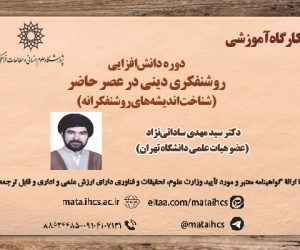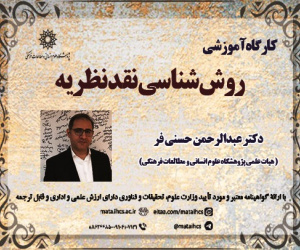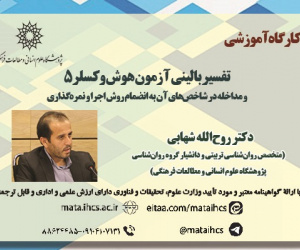تدوین مدل تعهد دینی بر اساس سبک دلبستگی به خدا با نقش میانجی تصویر ذهنی از خدا (مقاله علمی وزارت علوم)
درجه علمی: نشریه علمی (وزارت علوم)
آرشیو
چکیده
تعهد مذهبی بیان می کند یک فرد تا چه اندازه درگیر با امور و مفاهیم مذهبی است یا به عبارت دیگر فردی با تعهد مذهبی بالا در زندگی و امور روزمره خود به دین پایبند است. یکی از مهم ترین مواردی که می توان بر ارتباط های انسان همچون با خدا اثر بگذارد، سبک دلبستگی است. دلبستگی از نظر بالبی ، پیوند عاطفی پایداری می باشد که ویژگی آن گرایش به جستجو و حفظ مجاورت به شخص خاص به ویژهبه ویژه در زمان استرس می باشد، پاتریک با مفهوم سبک دلبستگی به خدا بر این باور بود که تفاوت های فردی سبک های دلبستگی بزرگسال و تاریخچه دلبستگی دوران کودکی در یک نقطه زمانی با تفاوت های فردی عقاید مذهبی و الگوهای روان شناختی از خدا هماهنگ هستند؛ از این رو بین ادراک دلبستگی دوران کودکی و اعتقادات انسان به خدا نیز رابطه وجود دارد. از نظر پاتریک زمانی که شخص درمانده است، همان ارتباطی را با خدا برقرار می کند که در خلال کودکی با والدین خود داشته است و سبک های دلبستگی به والد احتمالاً پایه شکل گیری ارتباط با خدا می شود، انواع سبک های دلبستگی به خدا عبارت اند از: دلبستگی ایمن به خدا، دلبستگی اضطرابی به خدا و دلبستگی اجتنابی به خدا. لارنس تصور از خدا را مفهومی شناختی از خداوند تعریف می کند که برداشتی شهودی از خدا است و از راه مجموعه ای از یادآوری ها، تداعی های مرتبط با آن و تجربه ها مشخص می شود. بر اساس پیشینه نظری و عملی پژوهش تصویر خدا متغیری شناخته می شود که هم با تعهد دینی و هم با سبک دلبستگی به خدا در ارتباط است و می توان آن را به عنوان یک متعیر میانجی در نظر گرفت نظر به این آنکه این روابط در قالب یک مدل ساختاری بررسی نشده اند، هدف این پژوهش تدوین مدل تعهد دینی بر سبک دلبستگی به خدا با نقش میانجی تصویر ذهنی خدا. روش: پژوهش حاضر نظری و از نوع بنیادی و داده های مورداستفاده کمّی است. طرح پژوهش مطالعه توصیفی از نوع همبستگی مدل معادلات ساختاری است، می باشد. جامعه این پژوهش شامل دانشجویان دختر و پسر مقطع کارشناسی نیم سال دوم 1403-1402 دانشگاه آزاد اسلامی واحد یادگار امام بود که انتخاب نمونه به روش تصادفی خوشه ای انجام شد و داده ها با استفاده از مقیاس مقیاس تعهد مذهبی، مقیاس سبک دلبستگی به خدا و مقیاس تصویر ذهنی از خدا جمع آوری شدند. تحلیل داده ها با نرم افزارهای آماری SPSS-22 و AMOS-29 انجام شد. نتایج: نتایج نشان داد که مدل از شاخصه های برازش مطلوب برخوردار است و پس از برازش مدل نتایج نشان داد سبک دلبستگی اجتنابی به خدا با تعهد دینی رابطه مستقیم و منفی دارد، دلبستگی ایمن به خدا با تصویر مثبت رابطه مستقیم و مثبت دارد. دلبستگی اجتنابی به خدا با تصویر مثبت رابطه مستقیم و منفی دارد، دلبستگی دوسوگرا به خدا با تصویر مثبت از خدا رابطه مستقیم و منفی دارد، سبک دلبستگی ایمن با نقش میانجی تصویر مثبت از خدا با تعهد دینی رابطه غیرمستقیم و مثبت دارد. سبک دلبستگی دوسوگرا به خدا با نقش میانجی تصویر مثبت از خدا با تعهد دینی رابطه غیرمستقیم و منفی دارد، سبک دلبستگی اجتنابی با نقش میانجی تصویر منفی از خدا با تعهد دینی رابطه غیرمستقیم و منفی دارد. بحث: افراد ایمن در پرتو ایمنی و آرامش کسب شده از وجود خداوند فرصتی برای پرداختن به سطوح عالی نیازها می یابند؛ یعنی آنچه مازلو آن را خود شکوفایی می نامد ؛ مردم تمایل ذاتی به تبدیل شدن به خود واقعی شان دارند، یعنی تمام آنچه که می توانند باشندبرای دستیابی به این اهداف نهایی، تعدادی از نیازهای اساسی دیگر مانند نیاز به غذا، ایمنی، عشق و عزت نفس باید برآورده شود که خلاصه و عصاره آن در معنویت براساس علم وحی است که و ابزار مهم ایستادگی در مسیر سخت و پرچالش زندگی (انشقاق، 6) را مفهوم ایمان (عصر، 3) می داند که ایمان از معنای لغوی تصدیق و اعتقاد قلبی به کسی یاچیزی است و از معنای اصطلاحی آن، اعتقاد و تصدیق قلبی به خدا است. افرادی با دلبستگی اجتنابی به خدا دلیل نگاه منفی به خود و خدا، با ترس از صمیمیت در پی ردّ ارتباطات نزدیک می باشند این افراد گاها نگاه خرافی به مذهب دارند و آن را مانع زندگی و آزادی خود می دانند،؛ بنابراین با دیدی منفی از خود و خدا، رابطه ای سرد و فاصله فاصله دار ایجاد می کنند که در نتیجه منجر به اجتناب از خدا می شود. پیلاگ و همکاران (2016) نیز توضیح می دهند که در افراد نا ایمن مضطرب در جست و جوی مداوم صمیمت در رابطه با خدا همراه با اضطراب زیاد و تنش های فراوانی است؛ از این رو لذا افراد مضطرب برای این که از علاقه خدا اطمینان داشته باشند و نیز به علت ترس از طرد شدن، دوست دارند در روابط نزدیک کنترل شوند و کنترل را نشانه دوست داشتن می دانند که البته این احساس با خشم و اضطراب همراه است،. این افراد اعمال مذهبی را در جهت ترس از دست دادن خدا و یا ترس از مجازات الهی انجام می دهند. یکی از مهم ترین محدودیت های پژوهش ها با موضوع دینداری در ایران نبودن ابزارهای بومی مطابق با فرهنگ ایران و اسلامی است. منحصر بودن نمونه حاضر به دانشجویان ساکن تهران و میانگین سنی جوانی از محدودیت های این پژوهش است که نتایج حاصله را بایستی با احتیاط به گروه های مختلف و شهرهای دیگر تعمیم داد. در پایان پیشنهاد می شود مطالعات بیشتری با مقیاس های متنوع و نمونه های مختلف انجام پذیرد تا بتوان به چنین یافته هایی عمومیت بخشید. تقدیر و مشارکت نویسندگان: نویسندگان ابتدا شکرگزار خداوند و سپس تمام افرادی که در این پژوهش همراه بوده اند کمال قدردانی و تشکر را دارم. نویسنده اول مسئولیت طراحی، جمع آوری داده ها و تحلیل را انجام داده است و دارند نویسنده دوم مسئولیت هدایت فرایند کلی پژوهش را برعهده داشت و نویسنده سوم مسئولیت نظارت بر ابعاد مذهبی پژوهش را داشته است. تضاد منافع و تأمین مالی: نویسندگان اعلام کرده اند که هیچ تضاد منافع در این مقاله وجود ندارد و کلیه هزینه های پژوهش توسط نویسندگان تأمین شده است.Formulating a Model of Religious Commitment Based on Attachment Style to God with the Mediating Role of the Mental Image of God
Introduction: Religious commitment means the extent to which a person is involved in religious matters and concepts, or in other words, a person with a high religious commitment adheres to religion in his life and daily affairs. One of the most important things that can affect human relationships, such as with God, is attachment style. According to Bowlby, attachment is a firm emotional bond characterized by a tendency to seek and maintain a proximity to a specific person, especially in times of stress. Regarding the concept of attachment style to God, Patrick believed that individual differences in adult attachment styles and childhood attachment history at a point in time are consistent with individual differences in religious beliefs and psychological models of God; hence, there is also a relationship between the perception of childhood attachment and human beliefs in God. According to Patrick, when a person is helpless, he establishes the same relationship with God that he had with his parents during childhood, and attachment styles to the parents are likely to be the basis for the formation of a relationship with God. The types of attachment styles to God are as follows: secure attachment to God, anxious attachment to God, and avoidant attachment to God. Lawrence defines the image of God as a cognitive concept of God that is an intuitive perception of God and is determined through a set of memories, related associations, and experiences. Based on the theoretical and practical background of research, the image of God is known as a variable that is related to both religious commitment and attachment style to God and can be considered as a mediating variable. Given that these relationships have not been examined in the form of a structural model, the aim of this research is to formulate a model of religious commitment on attachment style to God with the mediating role of the mental image of God. Method: The present research is a theoretical and fundamental research and the used data are quantitative. This descriptive research is a correlation study, a structural equation model type. The population included male and female undergraduate students of the second semester of 2023-2024 at Islamic Azad University, Yadegar Imam Branch, whose sample selection was done by cluster random sampling and the data were collected using Worthington et al.'s religious commitment inventory, Patrick's attachment styles to God scale, and the Image of God scale. SPSS-22 and AMOS-29 are applied for analyzing the data. Results: The results indicated that the model has desirable fit characteristics and after the model fit, the results showed that avoidant attachment style to God has a direct and negative relationship with religious commitment. Secure attachment to God has a direct and positive relationship with the positive image of God and a direct and negative relationship with the negative image. Avoidant attachment to God has a direct and negative relationship with the positive image and a direct and positive relationship with the negative image. Ambivalent attachment to God has a direct and negative relationship with the positive and negative image. Secure attachment style with the mediating role of the positive image of God has an indirect and positive relationship with religious commitment. Ambivalent attachment style with the mediating role of the positive image of God has an indirect and negative relationship with religious commitment. Avoidant attachment style with the mediating role of the negative image of God has an indirect and negative relationship with religious commitment. Discussion: In the light of the safety and peace gained from God's existence, secure individuals find an opportunity to meet higher levels of needs; that is, what Maslow calls self-actualization. People have an inherent desire to become their true selves, that is, all that they can be. To achieve these ultimate goals, a number of other basic needs, such as the need for food, safety, love, and self-esteem, must be met, which is summarized in spirituality based on the science of revelation, which considers the concept of faith (Asr, 3) as an important means of standing on the difficult and challenging path of life (Inshiqaq, 6). Faith, in its literal meaning, is the affirmation and heartfelt belief in someone or something, and in its idiomatic meaning, it is the belief and heartfelt affirmation in God. People with the avoidant attachment to God, due to their negative view of themselves and God, fearing intimacy, seek to reject close relationships. These people sometimes have a superstitious view of religion and consider it an obstacle to their life and freedom; therefore, with a negative view of themselves and God, they create a cold and distant relationship, which ultimately leads to avoid God. Pilag et al. (2016) also explain that insecure and anxious people, constantly seeking for intimacy in relationship with God, have a high anxiety and tension; therefore, anxious people, in order to be sure of God's love and also due to the fear of rejection, like to be controlled in close relationships and they consider control as a sign of love, which of course is accompanied by anger and anxiety. These people do religious activities in order to fear losing God or the fear of divine punishment. One of the most important limitations of the studies on the subject of religiosity in Iran is the lack of native tools in accordance with Iranian and Islamic culture. One of the limitations of this research is that the present sample is confined to students living in Tehran and their young average age, so the results should be generalized to different groups and other cities with caution. Finally, it is suggested that more studies be conducted with diverse scales and different samples in order to generalize such findings. Acknowledgements: The authors would like to express their gratitude to God first and then to all the people who participated in this research. The first author was responsible for the design, data collection, and analysis. The second author was responsible for guiding the overall research process, and the third author was responsible for supervising the religious aspects of the research. Conflicts of interest and funding: The authors declare that there are no conflicts of interest in this research and all research costs were covered by the authors.







